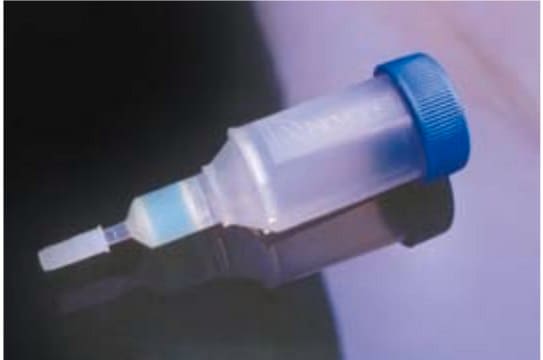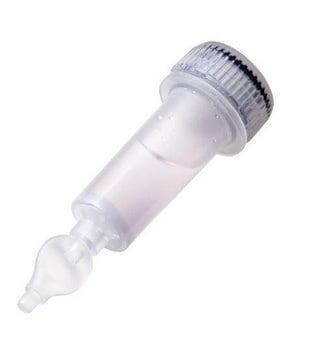Yes, Tris buffers should work.
Kluczowe dokumenty
P6611
HIS-Select® Nickel Affinity Gel
(1:1 suspension in a 20% ethanol solution)
Synonim(y):
agaroza naładowana niklem, Żywica Ni-NTA
Wybierz wielkość
744,00 zł
Wybierz wielkość
About This Item
744,00 zł
Polecane produkty
białko sprzężone
magnetic beads
Poziom jakości
Formularz
(1:1 suspension in a 20% ethanol solution)
Właściwości
hydrophilic
opakowanie
pkg of 1 mL
pkg of 100 mL
pkg of 25 mL
pkg of 5 mL
pkg of 500 mL
stężenie
1.5-2.4 mL/mL (suspension in packed gel)
metody
protein purification: suitable
kolor
faint blue to very dark blue
Matryca
6% Beaded Agarose
pojemność
>15 mg/mL, gel binding capacity (protein)(with an approx. 30 kDa protein)
temp. przejścia
flash point 32 °C (closed cup)
temp. przechowywania
2-8°C
Opis ogólny
Zastosowanie
Cechy i korzyści
- High selectivity for higher purity.
- Unique non-charged hydrophilic linkage reduces non-specific binding.
- Binding capacity for histidine-tagged protein is greater than 15 mg/mL.
- Binding under denaturing or non-denaturing conditions.
- One-step purification.
- Minimizes unwanted ionic interactions.
- Minimal nickel leaching.
- Bead size: 45-165 μm.
Powiązanie
Postać fizyczna
Przechowywanie i stabilność
Informacje prawne
produkt powiązany
Hasło ostrzegawcze
Warning
Zwroty wskazujące rodzaj zagrożenia
Zwroty wskazujące środki ostrożności
Klasyfikacja zagrożeń
Flam. Liq. 3
Kod klasy składowania
3 - Flammable liquids
Klasa zagrożenia wodnego (WGK)
WGK 3
Temperatura zapłonu (°F)
89.6 °F - closed cup
Temperatura zapłonu (°C)
32 °C - closed cup
Wybierz jedną z najnowszych wersji:
Certyfikaty analizy (CoA)
Nie widzisz odpowiedniej wersji?
Jeśli potrzebujesz konkretnej wersji, możesz wyszukać konkretny certyfikat według numeru partii lub serii.
Masz już ten produkt?
Dokumenty związane z niedawno zakupionymi produktami zostały zamieszczone w Bibliotece dokumentów.
Klienci oglądali również te produkty
Powiązane treści
Protein purification techniques, reagents, and protocols for purifying recombinant proteins using methods including, ion-exchange, size-exclusion, and protein affinity chromatography.
Techniki oczyszczania białek, odczynniki i protokoły oczyszczania rekombinowanych białek przy użyciu metod obejmujących wymianę jonową, wykluczenie wielkości i chromatografię powinowactwa białek.
Protein expression technologies for various expression systems supporting research, therapeutics, and vaccine production.
Technologie ekspresji białek dla różnych systemów ekspresji wspierające badania, terapie i produkcję szczepionek.
-
Can Tris buffers be used instead of phosphate buffer for HIS-Select® Nickel Affinity Gel, Product P6611?
1 answer-
Helpful?
-
-
Can imidazole be used with HIS-Select® Nickel Affinity Gel, Product P6611?
1 answer-
For column chromatography, no more than 20 mM is suggested in the extract, equilibration, and wash buffers to prevent non-specific binding of proteins. No more than 250 mM is suggested for the elution buffers. Many proteins will elute with imidazole levels as low as 100 to 200 mM. For batch methods the imidazole concentration may have to be reduced or eliminated.When a protein is expressed at low levels, the presence of the imidazole limits the binding of the protein in the batch method but not when used in a column.
Helpful?
-
-
What is the Department of Transportation shipping information for this product?
1 answer-
Transportation information can be found in Section 14 of the product's (M)SDS.To access the shipping information for this material, use the link on the product detail page for the product.
Helpful?
-
-
What needs to be done if the HIS-Select® Nickel Affinity Gel, Product P6611, resin turns brown on reuse?
1 answer-
During purification many protein extracts tend to discolor an affinity gel during the loading step. The original color will return after the wash or elution step. If the color is still not changing strip and recharge the affinity gel with nickel. Wash with EDTA and recharge with Nickel solution.
Helpful?
-
-
Can I use SDS with HIS-Select® Nickel Affinity Gel, Product P6611?
1 answer-
0.1% SDS has been used with some samples, with no adverse effects on the observed protein binding. However, SDS will effectively coat proteins and may block the binding to the column. It is probably very protein-specific and an SDS concentration that works for one protein may not work for another.
Helpful?
-
-
Why won't my recombinant protein with a histidine-containing tag bind to HIS-Select® Nickel Affinity Gel, Product P6611?
1 answer-
Verify the pH and composition of sample and equilibration buffers. Make sure there are no chelating or reducing agents present in the extraction buffer. If using the batch mode, remove imidazole. Run the affinity purification under denaturing conditions. Run a Western blot of the extract to verify that the recombinant protein is present.
Helpful?
-
Active Filters
Nasz zespół naukowców ma doświadczenie we wszystkich obszarach badań, w tym w naukach przyrodniczych, materiałoznawstwie, syntezie chemicznej, chromatografii, analityce i wielu innych dziedzinach.
Skontaktuj się z zespołem ds. pomocy technicznej









